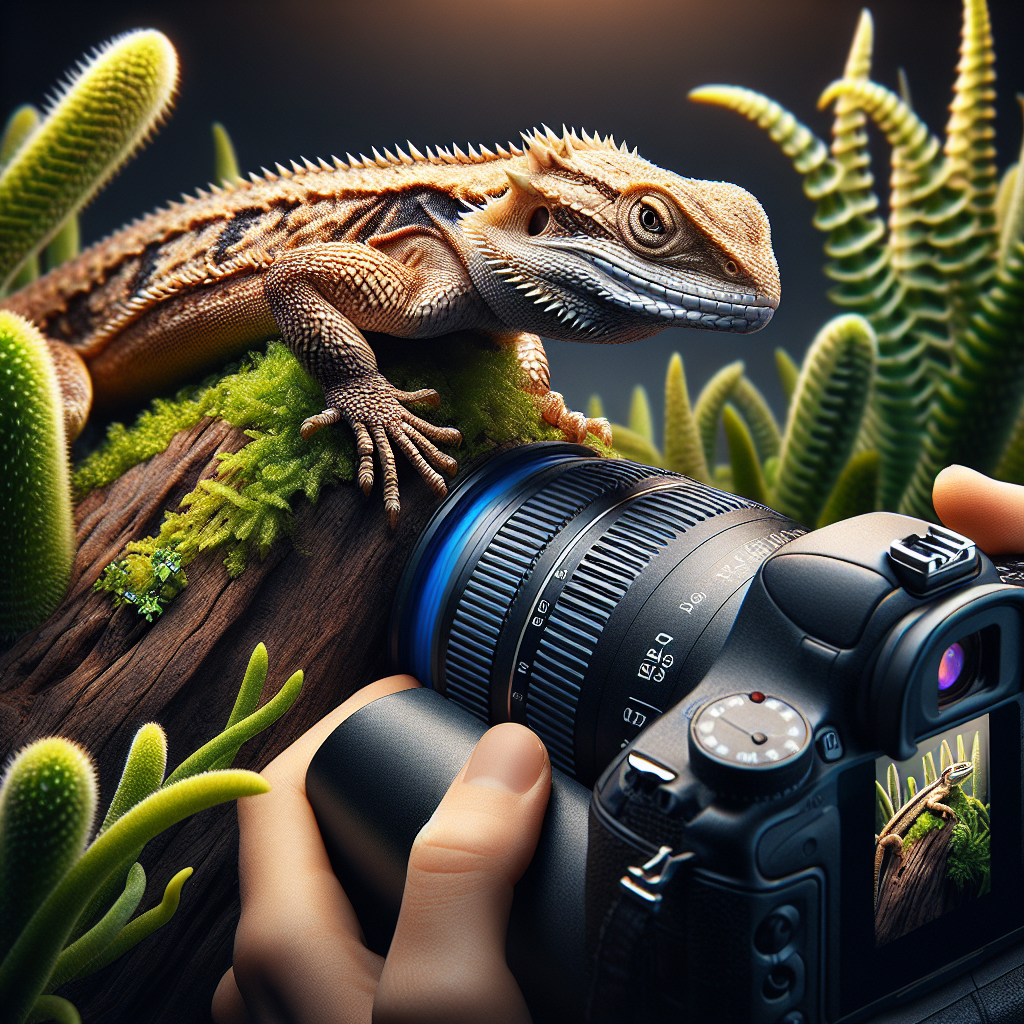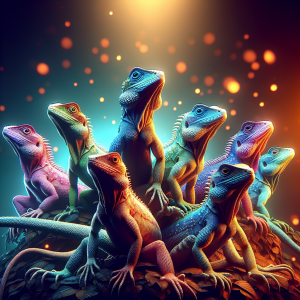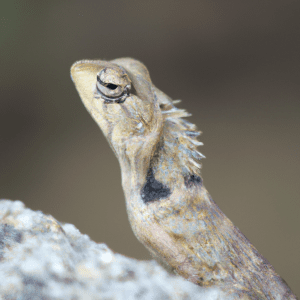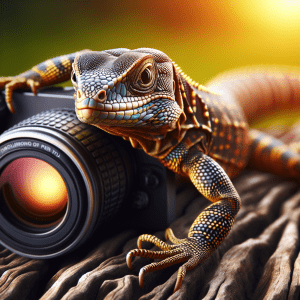Introduction: Understanding the Importance of Freezing Motion in Lizard Photography
Have you ever tried to capture the vibrant energy of a lizard in motion through photography? It’s a thrilling experience that requires skill and precision. As an expert in freezing motion in lizard photography, I’ve spent countless hours perfecting the art of capturing dynamic shots of these fascinating creatures.
One practical tip that I always emphasize is the importance of selecting the right camera equipment. Lizards are quick and agile, so having a camera that can keep up with their movements is crucial. Investing in a camera with fast autofocus capabilities and a high shutter speed can make all the difference in freezing motion and capturing those split-second moments.
When I first started experimenting with lizard photography, I faced the challenge of predicting their movements and adjusting my camera settings on the fly. It was a learning curve, but with patience and practice, I honed my skills in tracking and capturing lizards in motion.
The thrill of freezing motion in lizard photography lies in the ability to showcase the dynamic beauty of these creatures in their natural habitat. By mastering camera settings, honing your tracking techniques, and embracing the challenge of capturing motion, you can elevate your lizard photography to new heights. So, are you ready to embark on a journey of capturing the mesmerizing movements of lizards through your lens?
Choosing the Right Camera Equipment for Capturing Dynamic Shots
When it comes to freezing motion in lizard photography, choosing the right camera equipment is key. Selecting the proper gear can make a world of difference in capturing those dynamic shots of lizards in action.
Investing in a camera with a high shutter speed capability is essential for freezing motion effectively. This allows you to capture those split-second movements with clarity and precision.
I remember a time when I underestimated the importance of camera equipment in freezing motion shots. I was out in the field, trying to capture a lizard darting across a rock, but my camera just couldn’t keep up. That’s when I realized the significance of having the right tools for the job.
Choosing a camera with a fast autofocus system can also greatly enhance your ability to capture lizards in motion. This feature helps you track and focus on your subject swiftly, ensuring you don’t miss those fleeting moments.
So, the next time you’re gearing up for a lizard photography expedition, remember that your camera equipment plays a crucial role in freezing motion effectively. It’s not just about having the fanciest gear, but rather about selecting equipment that meets the specific demands of capturing dynamic lizard shots.
By investing in the right camera equipment and mastering its capabilities, you’ll be well on your way to creating stunning lizard photographs that truly capture the essence of these fascinating creatures in motion.
Mastering Camera Settings for Freezing Motion in Lizard Photography
Alright, let’s dive into mastering camera settings for freezing motion in lizard photography. Picture this: you’re out in the wild, trying to capture a lizard in action. It’s darting around, making quick movements that can easily blur in a photo. That’s where setting your camera right comes in handy.
First things first, adjust your shutter speed to a fast setting. This helps freeze the lizard’s motion in a crisp, detailed shot. Remember, the faster the movement, the higher the shutter speed needed.
Next up, consider your aperture settings. A wider aperture lets in more light but reduces depth of field. This can create a sharp focus on your lizard subject against a beautifully blurred background, adding a dynamic touch to your shot.
Experiment with your ISO settings too. Higher ISO values can help in low-light conditions but may introduce noise. Find the balance that suits your shooting environment best.
And don’t forget about your autofocus mode. Switch to continuous autofocus to track the lizard’s movement smoothly as you shoot. It’s like having a virtual assistant keeping your subject in focus as it moves around.
By mastering these camera settings, you’ll be well on your way to capturing stunning, dynamic images of lizards in motion. Trust me, once you nail down these techniques, your lizard photography game will reach a whole new level!
Tips for Selecting the Ideal Shooting Location for Dynamic Lizard Shots
When it comes to capturing dynamic shots of lizards in motion, the choice of shooting location can make all the difference. Picture this: you’re out in the wild, surrounded by lush greenery and the sun casting a warm glow. The right setting can elevate your lizard photography game from good to exceptional.
Selecting a shooting location that complements the natural habitat of lizards can add depth and context to your images. Whether it’s a rocky terrain for basking lizards or a dense forest for tree-dwelling species, each location offers a unique backdrop for your photography.
Consider the lighting conditions at different times of the day. Early mornings and late afternoons often provide soft, golden light that enhances the textures and colors of the lizards. Experiment with the play of light and shadow to create dramatic effects in your photographs.
Remember, patience is key when scouting for the perfect shooting location. Take the time to observe the behavior of the lizards in their environment. By understanding their movements and habits, you can anticipate the best moments to freeze their motion in your photographs.
So, next time you venture out to capture dynamic shots of lizards in motion, pay attention to the location – it could be the secret ingredient to transforming your images into works of art.
Techniques for Tracking and Capturing Lizards in Motion
Have you ever tried to capture the swift movements of lizards in a photograph? It can be quite a challenge, but with the right techniques, you can freeze that motion and create stunning images that truly capture the essence of these fascinating creatures.
One practical tip for freezing motion in lizard photography is to use a fast shutter speed. Lizards are quick and agile, so to prevent motion blur, you’ll want to set your camera to a high shutter speed to capture them in action crisply and clearly.
When I was out in the field photographing lizards, I found that anticipating their movements was key. By observing their behavior and predicting their next actions, I was able to position myself and adjust my settings to capture those dynamic moments with precision.
Did you know that some lizard species can move at incredibly high speeds, making them a challenging subject for photographers? By mastering the art of freezing motion, you can showcase their agility and grace in a way that truly mesmerizes viewers.
So, the next time you’re out photographing lizards, remember to experiment with different shutter speeds, track their movements, and be patient. With practice and perseverance, you’ll be able to freeze motion in your lizard photography and create captivating images that showcase the beauty and speed of these remarkable creatures.
Composition Tips for Creating Dynamic and Engaging Lizard Photographs
Alright, folks, let’s dive into the fascinating world of lizard photography and talk about composition tips. Picture this – you’re out in the wild, camera in hand, tracking a speedy lizard as it darts across the rocks.
To capture that dynamic shot, consider the rule of thirds. Instead of centering the lizard in the frame, position it off-center for a more visually appealing composition.
Another tip is to play with leading lines in your composition. Use elements like branches or rocks to guide the viewer’s eye towards the lizard, creating a sense of movement and flow in the image.
Now, let me share a personal anecdote with you. Once, I was focusing on capturing a lizard mid-leap, and by applying these composition tips, I ended up with a stunning shot that truly captured the lizard’s agility.
By incorporating these composition techniques, you can elevate your lizard photography to a whole new level, creating dynamic and engaging images that draw viewers in.
So, next time you’re out photographing lizards in motion, remember to experiment with composition, play with different angles, and let your creativity soar. Trust me, the results will speak for themselves. Get out there and capture those breathtaking moments!
Lighting Considerations for Freezing Motion in Lizard Photography
Have you ever considered how lighting can truly make or break a photograph? When it comes to freezing motion in lizard photography, lighting plays a crucial role in capturing those dynamic moments. Picture this: you’re out in the wild, tracking a lizard as it scurries across the terrain. Now, imagine the sun casting just the right amount of light to highlight every detail of its movement. That’s the magic of lighting in action.
Here’s a practical tip for you: when aiming to freeze motion in your lizard photographs, pay attention to the direction and intensity of the light. Harsh, direct sunlight can create strong shadows and wash out colors, while diffused light can lend a soft, even tone to your images. Experiment with different lighting conditions to see how they impact the overall mood and clarity of your shots.
By mastering the art of utilizing lighting in your lizard photography, you can elevate your images from ordinary to extraordinary. Consider how the play of light and shadow can add depth and dimension to your photographs, enhancing the sense of motion and energy within the frame. So, next time you’re out photographing lizards in action, take a moment to observe how lighting influences the dynamics of your shots. Trust me, you’ll be amazed at the difference it can make in freezing motion and capturing stunning images.
Post-Processing Tips to Enhance Motion and Detail in Lizard Images
When it comes to post-processing your lizard photographs to enhance motion and detail, there’s a world of possibilities waiting for you to explore. Imagine unleashing your creativity on those dynamic shots, bringing out the subtle nuances and vibrant energy captured in each frame.
Let me share a practical tip with you: consider experimenting with different editing tools and techniques to truly make your lizard images pop. From adjusting contrast and saturation to highlighting specific details, the post-processing stage is where the magic happens.
Picture this: you’ve just captured an incredible moment of a lizard in mid-air, and now it’s time to elevate that image to new heights through editing. By carefully fine-tuning the colors, sharpening the details, and enhancing the overall composition, you can transform a good photograph into a breathtaking work of art.
By taking the time to delve into the world of post-processing, you can unlock the full potential of your lizard photography and create images that not only freeze motion but also evoke emotion and storytelling. So, grab your editing software and get ready to bring your lizard shots to life in ways you never thought possible.
Showcasing Your Dynamic Lizard Photographs: Sharing and Display Options
Are you ready to take your lizard photography to the next level and showcase your dynamic shots to the world? When it comes to sharing your captivating lizard images, there are a multitude of options to consider. From creating stunning prints to digital displays, the possibilities are endless.
Imagine walking into a room and seeing your striking lizard photographs displayed on a gallery wall, captivating everyone who lays eyes on them. Whether you choose to print your images on high-quality canvas for a classic look or opt for sleek metal prints for a modern touch, the impact of your work will be undeniable.
But why stop there? With the digital age in full swing, sharing your lizard photography online opens up a whole new world of possibilities. Social media platforms like Instagram and Facebook provide a platform to showcase your work to a global audience, garnering likes, shares, and comments from fellow photography enthusiasts.
Have you ever considered creating a dedicated website or online portfolio to curate your best lizard images in one place? This not only serves as a digital gallery for your work but also allows you to connect with potential clients or collaborators who are drawn to your unique style.
The key is to find the right balance between showcasing your creativity and engaging your audience. Whether you choose to exhibit your lizard photography in traditional print form or explore the digital realm, the goal remains the same: to share your passion for capturing dynamic moments in the world of lizard photography.
Conclusion: Elevating Your Lizard Photography Skills with Motion-Freezing Techniques
Imagine being able to freeze the graceful motion of a lizard in a single photograph. It’s like capturing a fleeting moment of magic that you can relive forever. As one of the leading experts in the field of lizard photography, I can attest to the sheer thrill of mastering the art of freezing motion in your shots.
Choosing the right camera equipment is crucial, ensuring you have the tools to capture every detail flawlessly. Camera settings play a pivotal role in freezing motion, allowing you to seize those dynamic lizard movements with precision.
Picture this – you’re out in the wild, tracking a lizard as it scampers across the terrain. The challenge lies in keeping up with their swift pace while maintaining focus. But fear not, with the right techniques, you can conquer this challenge and capture stunning images that truly showcase the beauty of these creatures in motion.
Lighting is another essential element to consider. The interplay of light and shadow can elevate your lizard photographs, adding depth and drama to your shots.
Post-processing can further enhance the motion and detail in your images, taking your photography to the next level. The journey of freezing motion in lizard photography is a thrilling adventure, filled with endless opportunities for creativity and discovery. So, are you ready to embark on this exhilarating journey with me?




